Hvordan bruges 911facts.dk?

Hvordan får du mest ud af denne site?
Ny bog på dansk
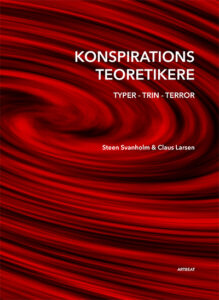
HVORFOR bliver folk konspirationsteoretikere?
HVORFOR er konspirations-
teoretikere så frustrerende at tale med?
HVORFOR er konspirations-
teoretikeres adfærd så ekstrem?
Disse spørgsmål bliver besvaret i denne bog, der samtidig klarlægger, hvorfor de gængse tiltag overfor konspirations-
teoretikere ikke virker.
Læs mere
Sandhedsbevægelsen
Publikationer
Booking
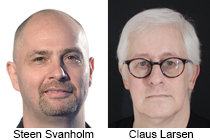
Er du interesseret i at booke os til foredrag eller workshop, så kan du gøre det her.

Privatlivspolitik

Læs om vores privatlivspolitik.
Flykaprerne var ikke uddannede til at flyve
Påstand
“…de mytiske 9/11 flykaprere havde lært sig de imponerende evner der satte dem i stand til at flyve passagerfly i flysimulatorer, selv om det er bevist, at de var for inkompetente til at flyve et lille Cessna 172.”0
Baggrund
Påstanden er fremsat af Nila Sagadevan, der er tilknyttet Physics9111, et videnskabeligt panel, bestående af blandt andre Kevin Barrett og Steven E. Jones, begge kendte navne i Truth-bevægelsen. Påstanden er også fremsat af medlemmer af den danske Truth-bevægelse2.
Senere citerer Sagadevan flykaprernes instruktører:
In fact, here’s what their flight instructors had to say about the aptitude of these budding aviators:
Mohammed Atta: “His attention span was zero.”
Khalid Al-Mihdhar: “We didn’t kick him out, but he didn’t live up to our standards.”
Marwan Al-Shehhi: “He was dropped because of his limited English and incompetence at the controls.”
Salem Al-Hazmi: “We advised him to quit after two lessons.”
Hani Hanjour: “His English was horrible, and his mechanical skills were even worse. It was like he had hardly even ever driven a car. I’m still to this day amazed that he could have flown into the Pentagon. He could not fly at all.”0
Fakta
Flykaprerne var inddelt i to funktioner:
- Den gruppe, der skulle styre flyene ind i deres mål. Gruppen bestod af fire af kaprerne.
- Den gruppe, der skulle overmande enhver modstand, og dermed sikre at flyene blev kapret, og forblev kapret, indtil målene blev nået. Gruppen bestod af de resterende 15 af kaprerne.
Kommisionsrapporten beskriver i detaljer hvilken uddannelse de fire piloter havde:

Mohamed Atta, American Airlines Flight 11
Huffman Aviation, Venice, Florida 3, 4, 5, 6
- Gennemgået flyveinstruktion
- Gennemgået “Accelerated Pilot Program”
- Foretaget soloflyvninger
- Bestået “Private pilot airman”-eksamen
- Bestået “State I”-eksamen for instrumentflyvning
- Bestået “Commercial pilot”-eksamen
- Opnået flyvelicens
- Trænet i flysimulator for store jetfly

Marwan al-Shehhi, United Airlines Flight 175
Huffman Aviation, Venice, Florida 7, 8, 9, 10
- Startede træning i 1997
- Bestået “Commercial pilot”-eksamen
- Opnået flyvelicens
- Trænet i flysimulator for store jetfly
Pan Am International Flight Academy, Mesa
- Fuldendt træning i flysimulator for Boeing 767

Hani Hanjour, American Airlines Flight 77
Arizona Aviation, Mesa, Arizona 11, 12
- Gennemgået “Accelerated Pilot Program”
- Foretaget soloflyvninger
- Bestået “Private pilot airman”-eksamen
- Bestået “State I”-eksamen for instrumentflyvning
- Bestået “Commercial pilot”-eksamen
- Opnået flyvelicens
- Trænet i flysimulator for store jetfly

Ziad Jarrah, United Airlines Flight 93
Florida Flight Training Center 13, 14
- Gennemgået privatpilotprogram
- Opnået flyvecertifikat til enkeltmotoret fly
Det står derfor klart, at alle fire flykaprere havde tilstrækkelig kendskab og øvelse i at flyve de kaprede maskiner. Nila Sagadevans citater fra flyinstruktørerne er dermed stærkt manipulerende, idet han tager dem ud af en sammenhæng, hvor han bevidst undlader at sige, at flykaprerne faktisk kunne flyve.
Som færdiguddannet pilot på et passagerfly bliver man ikke kun trænet i at flyve, men i særdeleshed at flyve sikkert. Derfor går træningen også på at kunne håndtere de talrige forskellige problemer, der kan opstå under en flyvning.
Dette var ikke nødvendigt for flykaprerne: Målet med træningen var ikke at uddanne flykaprerne til at flyve som normalt uddannede piloter. Målet var udelukkende at uddanne dem nok til at kunne styre flyene ind i de planlagte mål. Dette er åbenbart, når man ser på den kurs de enkelte fly fortsatte med på vej mod deres mål. De skulle så at sige blot overtage styrepinden, vende flyet og flyve det ind i målet.
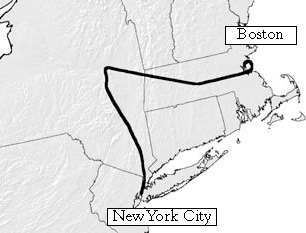 Flight 11 |
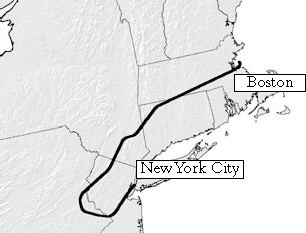 Flight 175 |
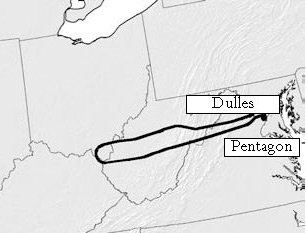 Flight 77 |
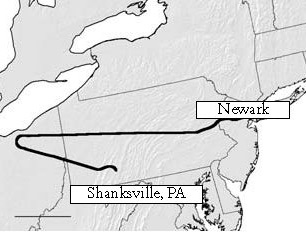 Flight 93 |
Logik
Der opstår flere spørgsmål i kølvandet på påstanden.
Hvis flykaprerne ikke havde træning nok til at kontrollere flyene:
- Hvem var det så passagererne angreb i cockpittet på Flight 93?
- Hvordan kunne de så ramme tårnene så præcist, at de jævnfør en anden konspirationsteoretisk påstand ramte netop de rigtige etager hvor sprængstofferne var placeret?
- Hvad så med piloterne, der i så fald må have kontrolleret flyene? Hvordan er de blevet overtalt/tvunget til at ramme tårnene/Pentagon?
Hvis der eksisterer en konspiration, der har udnyttet terrorister til at tro, at de skulle kapre flyene og ramme bygningerne, hvorfor har man så ikke valgt piloter der var højt kvalificerede?
Påstanden anerkender desuden, at der var flykaprere, hvilket modsiger en anden og hyppig påstand, nemlig at der ingen flykaprere var, men at flyene var fjernstyrede.
Konklusion
Påstanden er med andre ord:
- Usand
- Ulogisk
- Manipulerende
Kilder
-
“There are some who maintain that the mythical 9/11 hijackers, although proven to be too incompetent to fly a little Cessna 172, had acquired the impressive skills that enabled them to fly airliners by training in flight simulators.”0
The Impossibility of Flying Heavy Aircraft Without Training, Nila Sagadevan
- Physics911
- Jakob Hede Madsen og Niels Harrit, Go’Morgen Danmark, 11. december 2007
- The 9/11 Commission Report, side 224
After visiting the Airman Flight School in Norman, Oklahoma (where Zacarias Moussaoui would enroll several months later and where another al Qaeda operative, Ihab Ali, had taken lessons in the mid-1990s), Atta started flight instruction at Huffman Aviation in Venice, Florida, and both Atta and Shehhi subsequently enrolled in the Accelerated Pilot Program at that school. By the end of July, both of them took solo flights, and by mid-August they passed the private pilot airman test. They trained through the summer at Huffman, while Jarrah continued his training at FFTC.
- The 9/11 Commission Report, side 224
In late September, they decided to enroll at Jones Aviation in Sarasota, Florida, about 20 miles north of Venice.According to the instructor at Jones, the two were aggressive, rude, and sometimes even fought with him to take over the controls during their training flights. In early October, they took the Stage I exam for instruments rating at Jones Aviation and failed. Very upset, they said they were in a hurry because jobs awaited them at home. Atta and Shehhi then returned to Huffman.
- The 9/11 Commission Report, side 227
Atta and Shehhi finished up at Huffman and earned their instrument certificates from the FAA in November. In mid-December 2000, they passed their commercial pilot tests and received their licenses. They then began training to fly large jets on a flight simulator. At about the same time, Jarrah began simulator training, also in Florida but at a different center. By the end of 2000, less than six months after their arrival, the three pilots on the East Coast were simulating flights on large jets.
- The 9/11 Commission Report, side 229
After returning to Florida from their trips, Atta and Shehhi visited Georgia, staying briefly in Norcross and Decatur, and renting a single-engine plane to fly with an instructor in Lawrenceville.
- The 9/11 Commission Report, side 224
After visiting the Airman Flight School in Norman, Oklahoma (where Zacarias Moussaoui would enroll several months later and where another al Qaeda operative, Ihab Ali, had taken lessons in the mid-1990s), Atta started flight instruction at Huffman Aviation in Venice, Florida, and both Atta and Shehhi subsequently enrolled in the Accelerated Pilot Program at that school. By the end of July, both of them took solo flights, and by mid-August they passed the private pilot airman test. They trained through the summer at Huffman, while Jarrah continued his training at FFTC.
- The 9/11 Commission Report, side 224
In late September, they decided to enroll at Jones Aviation in Sarasota, Florida, about 20 miles north of Venice.According to the instructor at Jones, the two were aggressive, rude, and sometimes even fought with him to take over the controls during their training flights. In early October, they took the Stage I exam for instruments rating at Jones Aviation and failed. Very upset, they said they were in a hurry because jobs awaited them at home. Atta and Shehhi then returned to Huffman.
- The 9/11 Commission Report, side 227
Atta and Shehhi finished up at Huffman and earned their instrument certificates from the FAA in November. In mid-December 2000, they passed their commercial pilot tests and received their licenses. They then began training to fly large jets on a flight simulator. At about the same time, Jarrah began simulator training, also in Florida but at a different center. By the end of 2000, less than six months after their arrival, the three pilots on the East Coast were simulating flights on large jets.
- The 9/11 Commission Report, side 229
After returning to Florida from their trips, Atta and Shehhi visited Georgia, staying briefly in Norcross and Decatur, and renting a single-engine plane to fly with an instructor in Lawrenceville.
- The 9/11 Commission Report, side 225-226
In 1996, Hanjour returned to the United States to pursue flight training, after being rejected by a Saudi flight school. He checked out flight schools in Florida, California, and Arizona; and he briefly started at a couple of them before returning to Saudi Arabia. In 1997, he returned to Florida and then, along with two friends, went back to Arizona and began his flight training there in earnest. After about three months, Hanjour was able to obtain his private pilot’s license. Several more months of training yielded him a commercial pilot certificate, issued by the Federal Aviation Administration (FAA) in April 1999.
- The 9/11 Commission Report, side 226-227
On December 8, Hanjour traveled to San Diego. His supposed destination was an English as a second language program in Oakland, California, which he had scheduled before leaving Saudi Arabia but never attended. Instead, as mentioned earlier, he joined Nawaf al Hazmi in San Diego. Hazmi and Hanjour left San Diego almost immediately and drove to Arizona. Settling in Mesa, Hanjour began refresher training at his old school, Arizona Aviation. He wanted to train on multi-engine planes, but had difficulties because his English was not good enough. The instructor advised him to discontinue but Hanjour said he could not go home without completing the training. In early 2001, he started training on a Boeing 737 simulator at Pan Am International Flight Academy in Mesa. An instructor there found his work well below standard and discouraged him from continuing. Again, Hanjour persevered; he completed the initial training by the end of March 2001.
- The 9/11 Commission Report, side 224
Jarrah arrived in Newark on June 27 and then flew to Venice. He immediately began the private pilot program at FFTC, intending to get a multi-engine license.
- The 9/11 Commission Report, side 224
In the meantime, Jarrah obtained a single-engine private pilot certificate in early August.
Q & A

